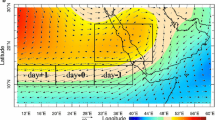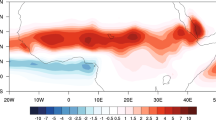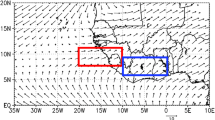Abstract
Janicot and Sultan (Geophys Res Lett 28(3):523–526, 2001) and Sultan et al. (J Clim 16(21):3389–3406, 2003) showed evidence of an intraseasonal signal of Sahelian rainfall corresponding to wet and dry sequences of the West African Monsoon. Using NCEP/NCAR reanalysis, NOAA outgoing longwave radiation (OLR) and observed daily rainfall over West Africa from 1968 to 1990, this paper investigates the variability of 3 to 5-day African Easterly Waves (AEWs), convection and their relationship with rainfall in these wet and dry sequences. The mean daily value rainfall during wet sequences is twice the mean value during dry sequences but the number of dry or wet sequences per year is not correlated with the annual rainfall. Wet sequences account for 39% of the annual accumulated rainfall while dry sequences account for 22%. The number of 3 to 5-day AEWs increases during wet years in wet sequences and the activity tends to be larger during wet years in both wet and dry sequences. These AEWs explain 40% of the accumulated rainfall during wet sequences whereas they contribute to 26% of the accumulated rainfall observed during dry sequences. Generally, they contribute to the increase of rainfall during these sequences. Mean convection is stronger and there are twice as many low OLR days (<225W/m2) during wet than dry sequences. The mean rainfall for days with high convective activity (convective days) is also twice as great during wet sequences. Rainfall that occurs during days without low OLR (weak convection with warm cloud tops or isolated deep convection) contributes to 69% of the total rainfall during dry sequences and 45% during wet sequences. A composite study was performed from day D 0−10 to day D 0+10 in each sequence. Wet (dry) sequences of the African monsoon start with a decrease (slight increase) of the negative meridional Ertel Potential Vorticity (PV) gradient at 700 hPa, associated with an increase (decrease) of the spectral density of AEWs. During the wet sequence, the African Easterly Jet (AEJ), detected by 700 hPa zonal wind, decreases and moves northward, whereas the Tropical Easterly Jet (TEJ), detected at 200 hPa, increases and shifts southward. Convective activity increases from D 0−6 to D 0−3 and remains high for 4 days in wet sequences. The daily rainfall increases (decreases) between D 0−6 and D 0 and returns to the mean value at D 0+4 for wet (dry) sequences.










Similar content being viewed by others
References
Burpee RW (1972) The origine and structure of easterly waves in the lower troposphere in North Africa. J Atmos Sci 29:77–80
Burpee RW (1974). Characteristics of North African easterly waves during the summers of 1968 and 1969. J Atmos Sci 31:1556–1570
D’Amato N, Lebel T (1998) On the characteristics of the rainfall events in the Sahel with a view to the analysis of climatic variability. Int J Climatol 18:955–974
Dickinson M, Molinari J (2002) Mixed rossby-gravity waves and Western Pacific Tropical cyclogenesis. part I: Synoptic evolution. J Atmos Sci 59:2183–2196
Diedhiou A, Janicot S, Viltard A, de Félice P (1998) Evidence of two regimes of easterly waves over West Africa and the tropical Atlantic. Geophys Res Lett 25:2805–2808
Diedhiou A, Janicot S, Viltard A, de Félice P, Laurent H (1999) Easterly waves regimes and associated convection over West Africa and the Tropical Atlantic: Results from the NCEP-NCAR and ECMWF reanalyses. Clim Dyn 15:795–822
Diedhiou A, Janicot S, Viltard A, de Félice P (2001) Composite patterns of easterly waves disturbances over West Africa and the tropical Atlantic: a climatology from the 1979-95 NCEP-NCAR reanalysis. Clim Dyn 18:241–253
Duvel JP (1990) Convection over Tropical Africa and the Atlantic ocean during northern summer. Part II: Modulation by Easterly Waves. Mon Weather Rev 118:1855–1868
Fink AH, Reiner A (2003) Spatio-temporal variability of the relation between African esterly waves and west African squall lines in 1998 and 1999. J Geophys Res 108:D11,4332 DOI 10.1029/2002JD002816
Grist JP (2002) Easterly waves over Africa. part I: the seasonal cycle and contrasts between wet and dry years. Mon Weather Rev 130:197–211
Gruber A, Krueger AF (1974) The status of the NOAA outgoing longwave radiation data set. Bull Am Meteorol Soc 65:958–962
Gu G, Adler RF, Huffman GJ, Curtis S (2004) African easterly waves and their association with precipitation. J Geophys Res 109:D0401, DOI 10.1029/2003JD003967
Hoskins BJ, McIntyre ME, Robertson AW (1985) On the use and significance of isentropic potential vorticity maps. QJR Meteorol Soc 111:877–946
Janicot S, Sultan B (2001) Intra-seasonal modulation of convection in the West African monsoon. Geophys Res Lett 28(3):523–526
Kalnay E, Kanamitsu R, Kistler R, Collins W et al (1996) The NCEP/NCAR 40-years reanalysis project. Bull Am Meteorol Soc 77:437–471
Laurent H, D’Amato N, Lebel T (1998) How important is the contribution of the mesoscale convective complexes to the Sahelian rainfall. Phys Chem Earth 23:629–633
Le Barbé L, Lebel T (1997) Rainfall climatology of the HAPEX-Sahel region during the years 1950–1990. J Hydrol 188:43–73
Lebel T, Diedhiou A, Laurent H (2003) Seasonal cycle and interannual variability of the Sahelian rainfall at hydrological scales. J Geophys Res 108(D8):8389 DOI 10.1029/2001JD001280
Liebmann B, Smith CA (1996) Description of a complete (interpolated) outgoing longwave radiation dataset. Bull Am Meteorol Soc 77:1275–1277
Mathon V, Diedhiou A, Laurent H (2002a) Relationship between easterly waves and mesoscale convective systems over the Sahel. Geophys Res Lett 29(8):1216
Mathon V, Laurent H, Lebel T (2002b) Mesoscale convective system rainfall in the Sahel. J Appl Meteorol 41:1081–1092
Matthews A (2004) Intraseasonal variability over tropical africa during northern summer. J Clim 17:2427–2440
Newell RE, Kidson JW (1984) African mean wind changes between Sahelian wet and dry period. J Climatol 4:1–7
Redelsperger JL, Diongue A, Diedhiou A, Ceron JP, Diop M, Gueremy JF, Lafore JP (2002) Multi-scale description of a Sahelian synoptic weather system representative of the West African monsoon. QJR Meteorol Soc 128:1229–1257
Reed RJ, Norquist DC, Recker EE (1977) The structure and properties of African wave disturbances as observed during Phase III of GATE. Mon Weather Rev 105:317–333
Rowell DP, Milford JR (1993) On the generation of African squall lines. J Clim 6:1181–1193
Schubert WH, Ciesielski PE, Stevens DE, Kuo HC (1991) Potential vorticity modeling of the ITCZ and the Hadley circulation. J Atmos Sci 48:1493–1509
Sultan B (2002) Etude de la mise en place de la mousson en Afrique de l’Ouest et de la variabilité intra - saisonnière de la convection. Application à la sensibilité des rendements agricoles. PhD thesis, Université Paris 7
Sultan B, Janicot S, Diedhiou A (2003) The West African Monsoon dynamics. part I: Documentation of intraseasonal variabilty. J Clim 16(21):3389–3406
Taleb EH, Druyan LM (2003) Relationships between rainfall and West African wave disturbances in station observations. Int J Climatol 23:305–313
Taylor CM, Parker DJ, Lloyd CR, Thorncroft CD (2005) Observations of synoptic-scale land surface variability and its coupling with the atmosphere. QJR Meteorol Soc 131:913–937
Thorncroft CD, Blackburn M (1999) Maintenance of the African easterly jet. QJR Meteorol Soc 125(555):763–786
Torrence C, Compo GP (1998) A practical guide to Wavelet analysis. Bull Am Meteorol Soc 79:61–78
Waliser DE, Zhou W (1997) Removing satellite equatorial crossing time biases from the olr and hrc datasets. J Clim 10:2125–2146
Weisman M, Rotunno R (2004) A theory for strong long-lived squall lines revisited. J Atmos Sci 61(4):361–382
Weng H, Lau KM (1994) Wavelets, period doubling, and time-frequency localization with application to organization of convection over the tropical western pacific. J Atmos Sci 51(17):2523–2541
Acknowledgments
The authors are very thankful to Climate Diagnostics Center (NOAA, Boulder, CO) for providing the NCEP/NCAR Reanalysis dataset. Authors also thank ASECNA (Agence pour la Securite de la Navigation Aerienne en Afrique et a Madagascar) and African National Meteorological and Hydrological Services for collecting the rainfall data and IRD for the ORE AMMA-CATCH database.
Author information
Authors and Affiliations
Corresponding author
Rights and permissions
About this article
Cite this article
Lavaysse, C., Diedhiou, A., Laurent, H. et al. African Easterly Waves and convective activity in wet and dry sequences of the West African Monsoon. Clim Dyn 27, 319–332 (2006). https://doi.org/10.1007/s00382-006-0137-5
Received:
Accepted:
Published:
Issue Date:
DOI: https://doi.org/10.1007/s00382-006-0137-5




